PAPR Reduction in UFMC for 5G Cellular Systems
Abstract
1. Introduction
- We assess the performance of the proposed Dcomp-SLM using communication metrics such as BER and EVM, in the presence of Rayleigh fading and AWGN channels.
- We maintain the same order of computational complexity as conventional SLM methods; however, with superior PAPR mitigation performance.
2. The UFMC System Model
2.1. UFMC Transmitter
2.2. UFMC Receiver
3. The Proposed Dcomposed SLM PAPR Reduction Technique
4. Numerical Results and Discussions
4.1. The CCDF-PAPR Performance
4.2. BER and EVM Performance
4.3. The PSD Performance
4.4. Discussions
5. Conclusions
Author Contributions
Funding
Acknowledgments
Conflicts of Interest
References
- Tao, Y.; Liu, L.; Liu, S.; Zhang, Z. A survey: Several technologies of non-orthogonal transmission for 5G. China Commun. 2015, 12, 1–15. [Google Scholar] [CrossRef]
- Rani, P.N.; Rani, C.S. UFMC: The 5G modulation technique. In Proceedings of the 2016 IEEE International Conference on Computational Intelligence and Computing Research (ICCIC), Chennai, India, 15–17 December 2016; pp. 1–3. [Google Scholar]
- Kamurthi, R.T. Review of UFMC Technique in 5G. In Proceedings of the 2018 International Conference on Intelligent Circuits and Systems (ICICS), Phagwara, India, 19–20 April 2018; pp. 115–120. [Google Scholar]
- Luo, F.L.; Zhang, C. Signal Processing for 5G: Algorithms and Implementations; John Wiley & Sons: Hoboken, NJ, USA, 2016. [Google Scholar]
- Cho, Y.S.; Kim, J.; Yang, W.Y.; Kang, C.G. MIMO-OFDM Wireless Communications with MATLAB; John Wiley & Sons: Hoboken, NJ, USA, 2010. [Google Scholar]
- Dai, L.; Wang, Z.; Yang, Z. Time-frequency training OFDM with high spectral efficiency and reliable performance in high speed environments. IEEE J. Sel. Areas Commun. 2012, 30, 695–707. [Google Scholar] [CrossRef]
- Hwang, T.; Yang, C.; Wu, G.; Li, S.; Li, G.Y. OFDM and its wireless applications: A survey. IEEE Trans. Veh. Technol. 2008, 58, 1673–1694. [Google Scholar] [CrossRef]
- Li, J.; Kearney, K.; Bala, E.; Yang, R. A resource block based filtered OFDM scheme and performance comparison. In Proceedings of the ICT 2013, Casablanca, Morocco, 6–8 May 2013; pp. 1–5. [Google Scholar]
- Selim, A.; Doyle, L. A method for reducing the out-of-band emissions for OFDM systems. In Proceedings of the 2014 IEEE Wireless Communications and Networking Conference (WCNC), Istanbul, Turkey, 6–9 April 2014; pp. 730–734. [Google Scholar]
- Liu, Y.; Chen, X.; Zhong, Z.; Ai, B.; Miao, D.; Zhao, Z.; Sun, J.; Teng, Y.; Guan, H. Waveform design for 5G networks: Analysis and comparison. IEEE Access 2017, 5, 19282–19292. [Google Scholar] [CrossRef]
- Schaich, F.; Wild, T. Waveform contenders for 5G—OFDM vs. FBMC vs. UFMC. In Proceedings of the 2014 6th International Symposium on Communications, Control and Signal Processing (ISCCSP), Athens, Greece, 21–24 May 2014; pp. 457–460. [Google Scholar]
- Banelli, P.; Buzzi, S.; Colavolpe, G.; Modenini, A.; Rusek, F.; Ugolini, A. Modulation formats and waveforms for 5G networks: Who will be the heir of OFDM: An overview of alternative modulation schemes for improved spectral efficiency. IEEE Signal Process. Mag. 2014, 31, 80–93. [Google Scholar] [CrossRef]
- Gerzaguet, R.; Bartzoudis, N.; Baltar, L.G.; Berg, V.; Doré, J.B.; Kténas, D.; Font-Bach, O.; Mestre, X.; Payaró, M.; Färber, M. The 5G candidate waveform race: A comparison of complexity and performance. EURASIP J. Wirel. Commun. Netw. 2017, 2017, 13. [Google Scholar] [CrossRef]
- Hu, K.C.; Armada, A.G. SINR analysis of OFDM and f-OFDM for machine type communications. In Proceedings of the 2016 IEEE 27th Annual International Symposium on Personal, Indoor, and Mobile Radio Communications (PIMRC), Valencia, Spain, 4–7 September 2016; pp. 1–6. [Google Scholar]
- Fettweis, G.; Krondorf, M.; Bittner, S. GFDM-generalized frequency division multiplexing. In Proceedings of the VTC Spring 2009-IEEE 69th Vehicular Technology Conference, Barcelona, Spain, 26–29 April 2009; pp. 1–4. [Google Scholar]
- Vakilian, V.; Wild, T.; Schaich, F.; ten Brink, S.; Frigon, J.F. Universal-filtered multi-carrier technique for wireless systems beyond LTE. In Proceedings of the 2013 IEEE Globecom Workshops (GC Wkshps), Atlanta, GA, USA, 9–13 December 2013; pp. 223–228. [Google Scholar]
- Wild, T.; Schaich, F.; Chen, Y. 5G air interface design based on universal filtered (UF-) OFDM. In Proceedings of the 2014 19th International Conference on Digital Signal Processing, Hong Kong, China, 20–23 August 2014; pp. 699–704. [Google Scholar]
- Nissel, R.; Schwarz, S.; Rupp, M. Filter bank multicarrier modulation schemes for future mobile communications. IEEE J. Sel. Areas Commun. 2017, 35, 1768–1782. [Google Scholar] [CrossRef]
- Cheng, X.; He, Y.; Ge, B.; He, C. A filtered OFDM using FIR filter based on window function method. In Proceedings of the 2016 IEEE 83rd Vehicular Technology Conference (VTC Spring), Nanjing, China, 15–18 May 2016; pp. 1–5. [Google Scholar]
- Fathy, S.A.; Ibrahim, M.; El-Agooz, S.; El-Hennawy, H. Low-Complexity SLM PAPR Reduction Approach for UFMC Systems. IEEE Access 2020, 8, 68021–68029. [Google Scholar] [CrossRef]
- Almutairi, A.F.; Al-Gharabally, M.; Krishna, A. Performance analysis of hybrid peak to average power ratio reduction techniques in 5G UFMC systems. IEEE Access 2019, 7, 80651–80660. [Google Scholar] [CrossRef]
- Wang, Y.; Zhang, R.; Li, J.; Shu, F. PAPR Reduction Based on Parallel Tabu Search for Tone Reservation in OFDM Systems. IEEE Wirel. Commun. Lett. 2019, 8, 576–579. [Google Scholar] [CrossRef]
- Anoh, K.; Tanriover, C.; Adebisi, B.; Hammoudeh, M. A new approach to iterative clipping and filtering PAPR reduction scheme for OFDM systems. IEEE Access 2017, 6, 17533–17544. [Google Scholar] [CrossRef]
- Yoshizawa, R.; Ochiai, H. Energy efficiency improvement of coded OFDM systems based on PAPR reduction. IEEE Syst. J. 2015, 11, 717–728. [Google Scholar] [CrossRef]
- Le Goff, S.Y.; Al-Samahi, S.S.; Khoo, B.K.; Tsimenidis, C.C.; Sharif, B.S. Selected mapping without side information for PAPR reduction in OFDM. IEEE Trans. Wirel. Commun. 2009, 8, 3320–3325. [Google Scholar] [CrossRef]
- Al-Rayif, M.I.; Seleem, H.; Ragheb, A.; Alshebeili, S. A Novel Iterative-SLM Algorithm for PAPR Reduction in 5G Mobile Fronthaul Architecture. IEEE Photonics J. 2019, 11, 1–12. [Google Scholar] [CrossRef]
- Jones, A.E.; Wilkinson, T.A.; Barton, S. Block coding scheme for reduction of peak to mean envelope power ratio of multicarrier transmission schemes. Electron. Lett. 1994, 30, 2098–2099. [Google Scholar] [CrossRef]
- Mabrouk, M.B.; Chafii, M.; Louet, Y.; Bader, F. A precoding-based PAPR reduction technique for UF-OFDM and filtered-OFDM modulations in 5G systems. In Proceedings of the 2017 23th European Wireless VDE, Dresden, Germany, 17–19 May 2017; pp. 1–6. [Google Scholar]
- Liang, H.Y. Selective Mapping Technique Based on an Adaptive Phase-Generation Mechanism to Reduce Peak-to-Average Power Ratio in Orthogonal Frequency Division Multiplexing Systems. IEEE Access 2019, 7, 96712–96718. [Google Scholar] [CrossRef]
- Ma, T.M.; Shi, Y.S.; Wang, Y.G. A novel SLM scheme for PAPR reduction in OFDM systems. J. Comput. Netw. Commun. 2011, 2011. [Google Scholar] [CrossRef]
- Valluri, S.; Mani, V. A novel approach for reducing complexity in the SLM-GFDM system. Phys. Commun. 2019, 34, 188–195. [Google Scholar] [CrossRef]
- Jawhar, Y.A.; Audah, L.; Taher, M.A.; Ramli, K.N.; Shah, N.S.M.; Musa, M.; Ahmed, M.S. A review of partial transmit sequence for PAPR reduction in the OFDM systems. IEEE Access 2019, 7, 18021–18041. [Google Scholar] [CrossRef]
- Elhelw, A.M.; Badran, E.F. Semi-Blind Error Resilient SLM for PAPR Reduction in OFDM Using Spread Spectrum Codes. PLoS ONE 2015, 10, e0127639. [Google Scholar] [CrossRef]
- Taşpinar, N.; Şimşir, Ş. PAPR Reduction Based on Partial Transmit Sequence Technique in UFMC Waveform. In Proceedings of the 2019 14th Iberian Conference on Information Systems and Technologies (CISTI), Coimbra, Portugal, 19–22 June 2019; pp. 1–6. [Google Scholar]
- Rong, W.; Cai, J.; Yu, X. Low-complexity PTS PAPR reduction scheme for UFMC systems. Clust. Comput. 2017, 20, 3427–3440. [Google Scholar] [CrossRef]
- Liu, K.; Ge, Y.; Liu, Y. An Efficient Piecewise Nonlinear Companding Transform for PAPR Reduction in UFMC Systems. In Proceedings of the 2019 IEEE/CIC International Conference on Communications in China (ICCC), Changchun, China, 11–13 August 2019; pp. 730–734. [Google Scholar]
- Fathy, S.A.; Ibrahim, M.N.; Elagooz, S.S.; El-Hennawy, H.M. Efficient SLM Technique for PAPR Reduction in UFMC Systems. In Proceedings of the 2019 36th National Radio Science Conference (NRSC), Port Said, Egypt, 16–18 April 2019; pp. 118–125. [Google Scholar]
- Al-Rayif, M.I. Optimal SLM PAPR Reduction based on I/Q-Complex Data Symbol Components. In Proceedings of the 2019 2nd IEEE Middle East and North Africa COMMunications Conference (MENACOMM), Manama, Bahrain, 19–21 November 2019; pp. 1–4. [Google Scholar]
- Harris, F.J. On the use of windows for harmonic analysis with the discrete Fourier transform. Proc. IEEE 1978, 66, 51–83. [Google Scholar] [CrossRef]
- Oppenheim, A.V. Discrete-Time Signal Processing; Pearson Education: Newark, NJ, USA, 1999. [Google Scholar]
- Van Nee, R.; De Wild, A. Reducing the peak-to-average power ratio of OFDM. In Proceedings of the VTC’98, 48th IEEE Vehicular Technology Conference, Pathway to Global Wireless Revolution (Cat. No. 98CH36151), Ottawa, ON, Canada, 21 May 1998; Volume 3, pp. 2072–2076. [Google Scholar]
- Rapp, C. Effects of HPA-nonlinearity on a 4-DPSK/OFDM-signal for a digital sound broadcasting signal. In Proceedings of the ESA, Second European Conference on Satellite Communications (ECSC-2), Liege, Belgium, 22–24 October 1991; pp. 179–184. [Google Scholar]


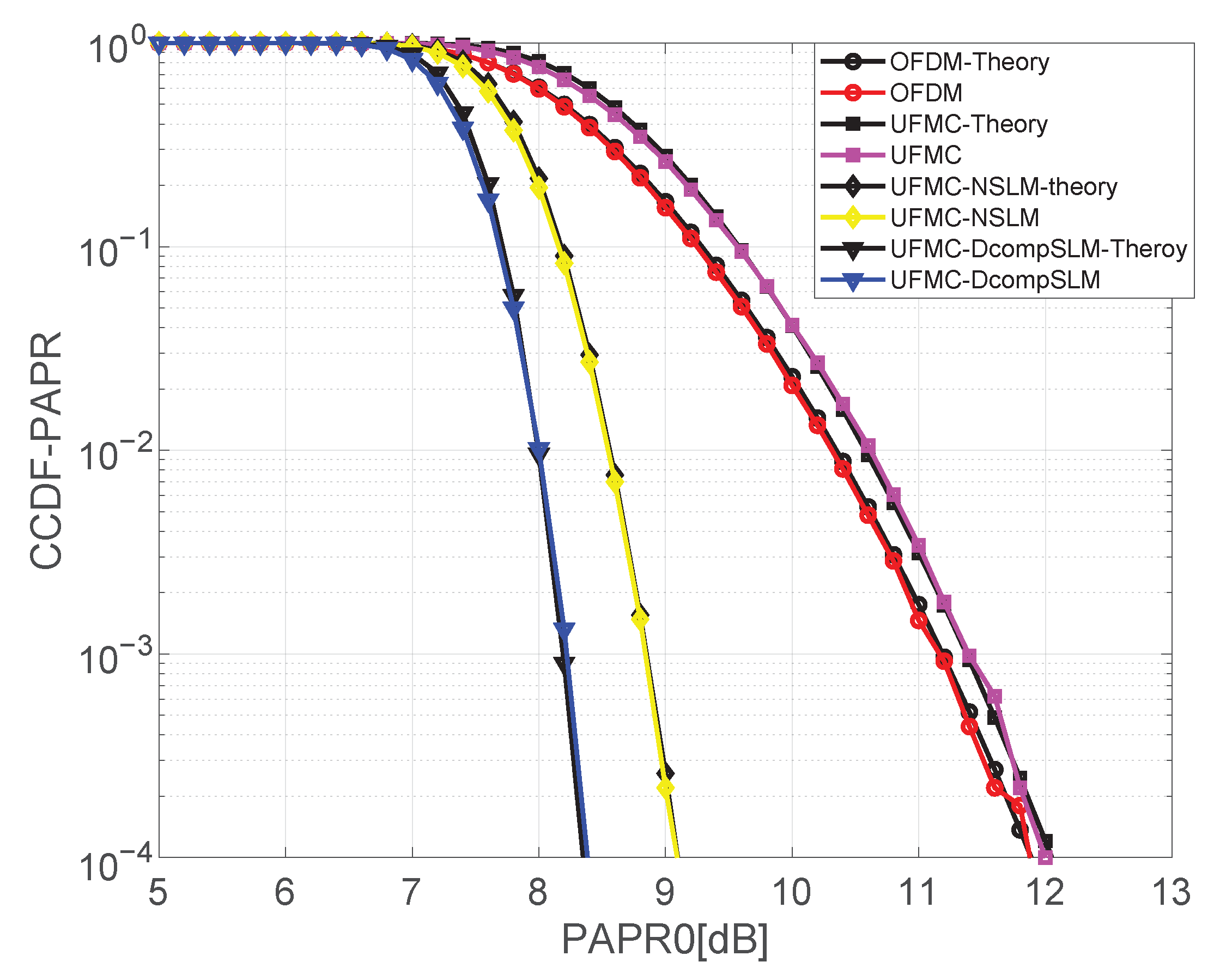
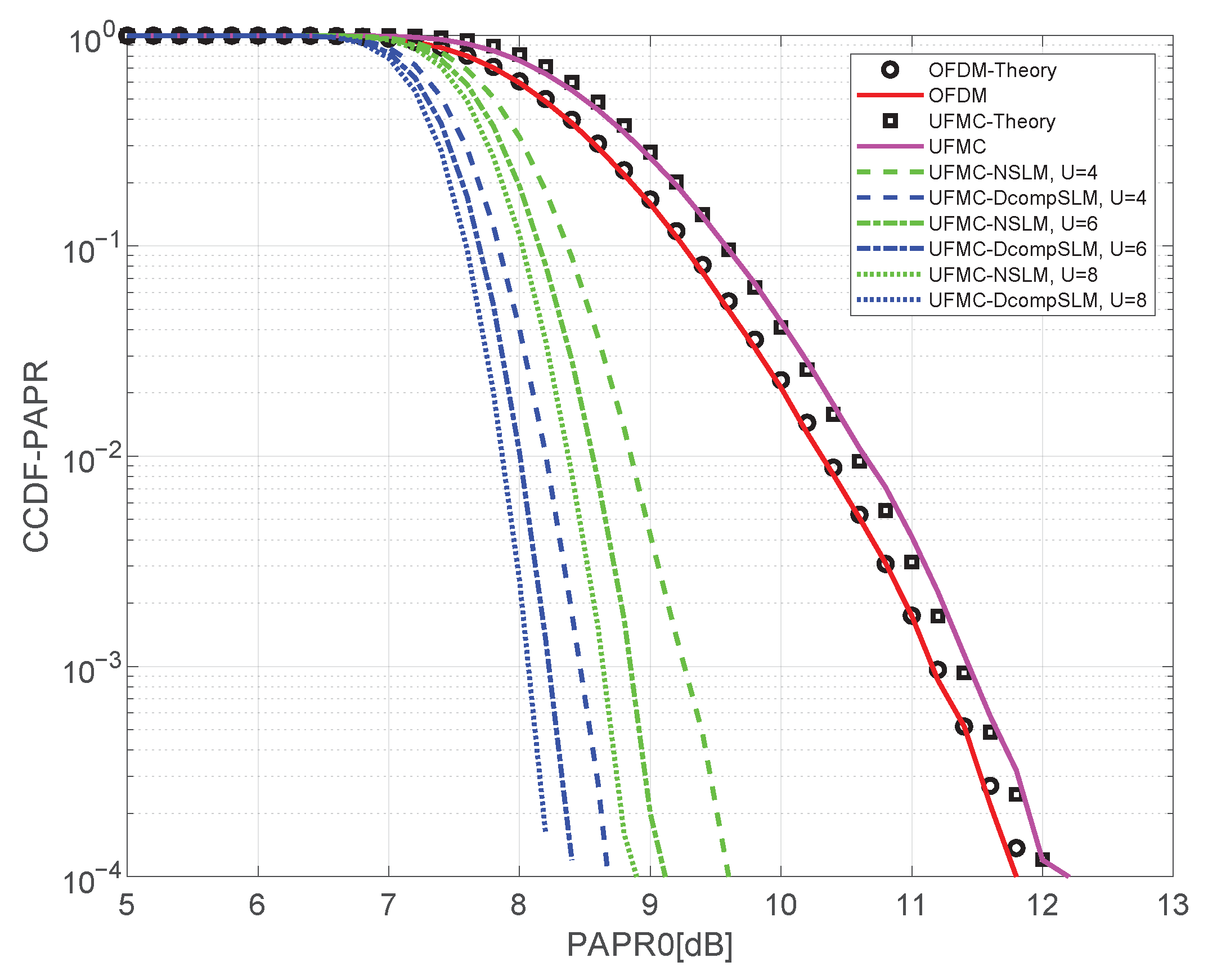
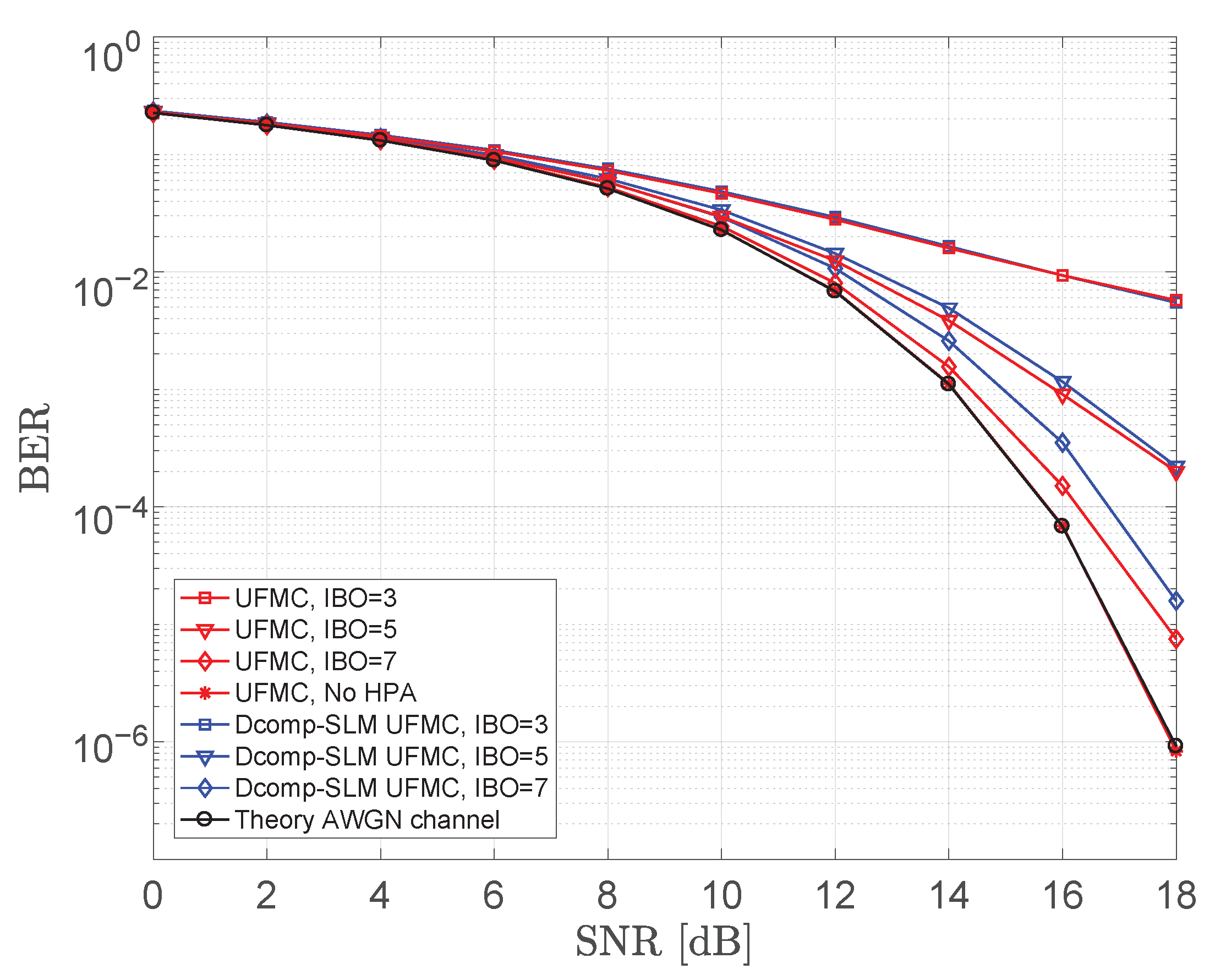


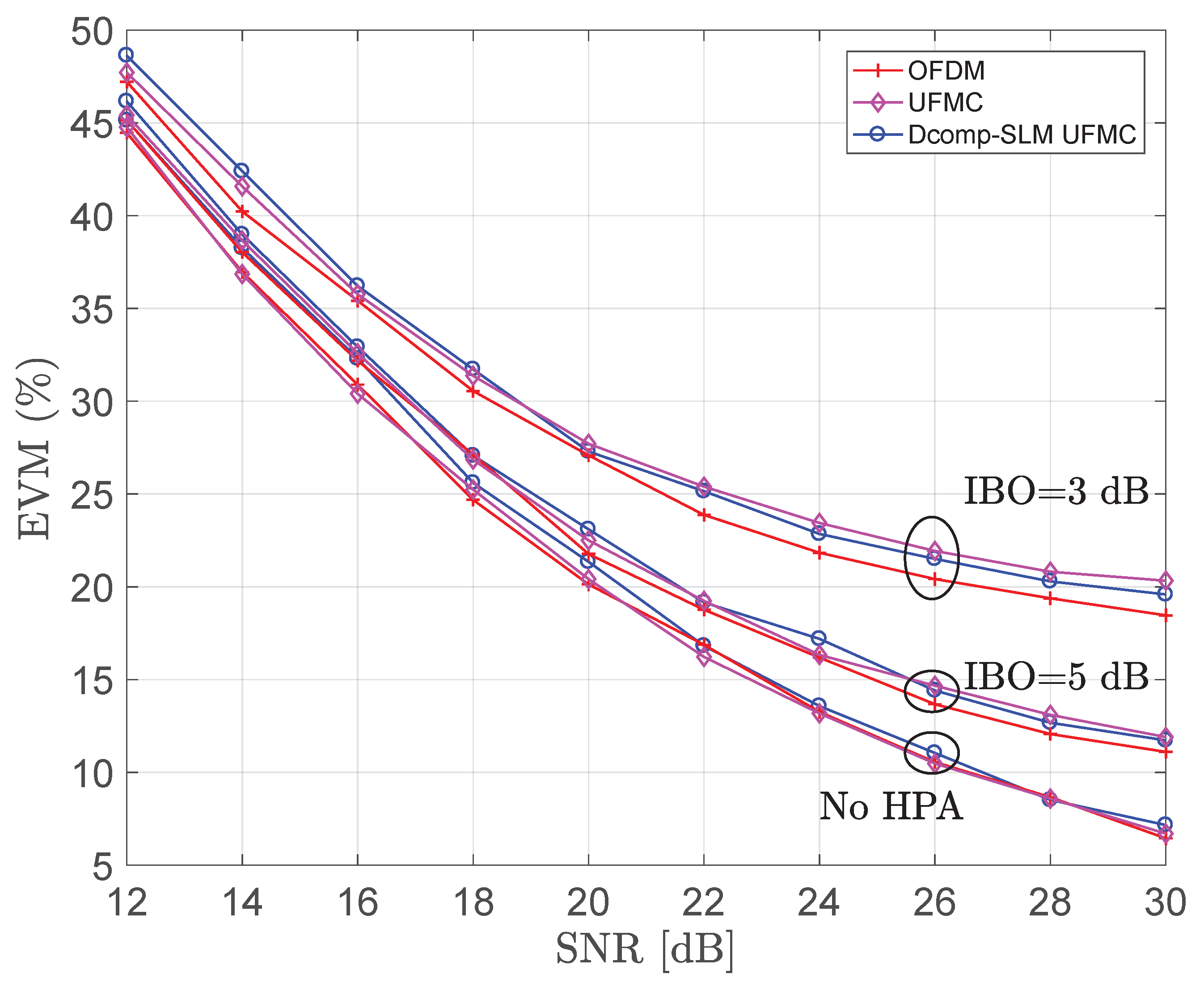
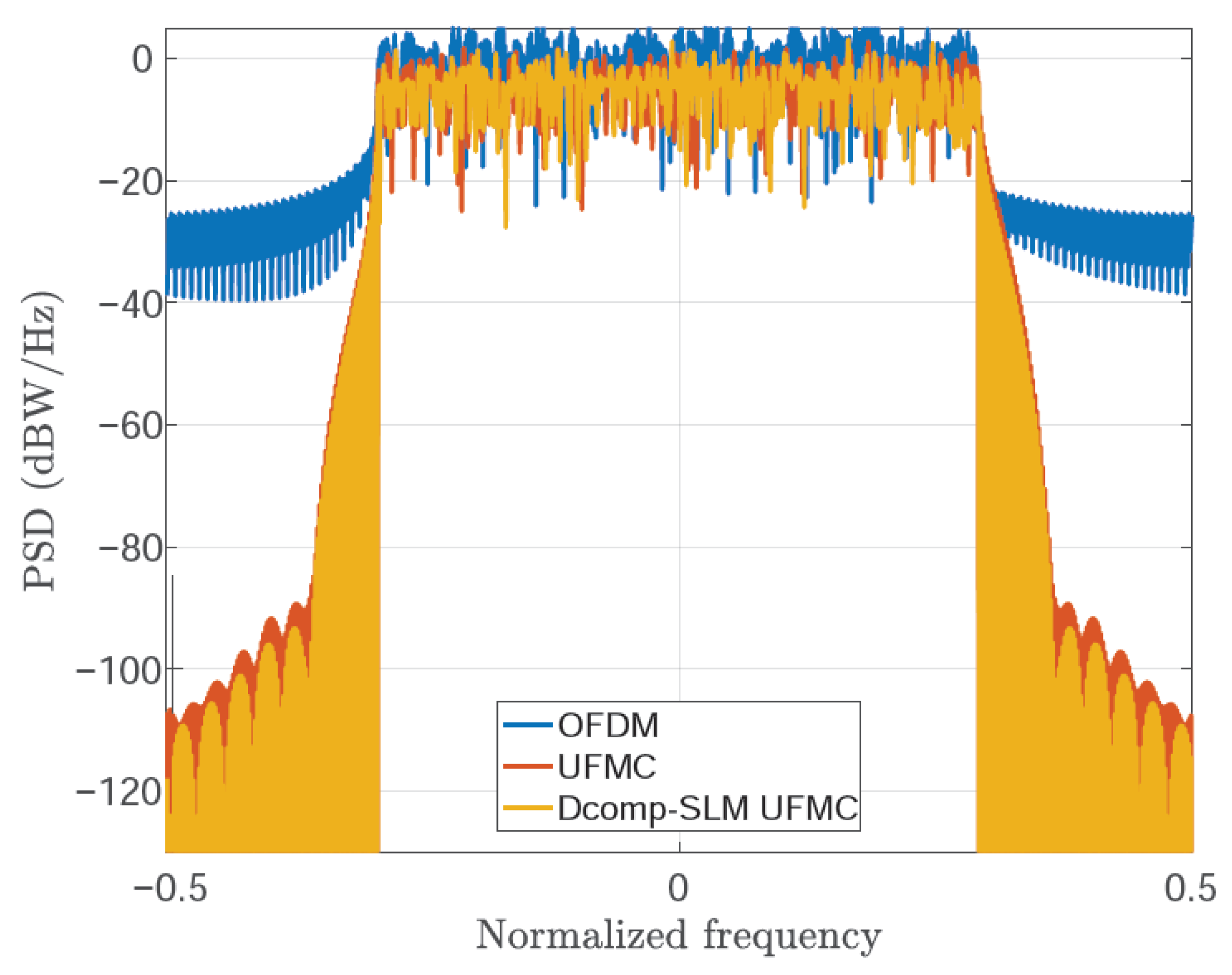
| Parameter | SLM-UFMC System |
|---|---|
| Number of data sub-carriers, | 300 |
| FFT size, N | 512 |
| Cyclic prefix length, | 128 |
| Modulation order, M | QPSK and 16-QAM |
| Filter length, | 37 |
| Number of sub-bands, B | 30 |
| Sub-band size, | 10 |
| High power amplifier (HPA) | SSPA (Rapp’s Model) |
| Channel model | Rayleigh fading channel |
| No of paths in fading channel, L | 64 |
| Number of phase vectors, U | 4, 6, and 8 |
| Filter type | Dolph-Chebyshev |
| Side lobe attenuation, | 60 dB |
| input back off () of SSPA | 5, 7, and 9 |
| Smoothness factor of SSPA, p | 3 |
| Technique [Ref.] | Simulation Parameters | Parameters of Comparisons | |||||
|---|---|---|---|---|---|---|---|
| PAPR (dB) | SNR (dB) | PSD (dB) | Computational Complexity | ||||
| CCFD = 10 | BER = 10 | at 1st SLL (OOB) | Multiplication | Addition | |||
| SLM | Dcomp-SLM (proposed) | U = 6, N = 512, B = 30, = 10, 16-QAM | 8.2 | 14 for AWGN and 30 for Rayleigh channels | −95 | ||
| P-SLM [20] | U = 16, N = 512, B = 25, = 12, 16-QAM | 8.4 | min. BER = 7 for Rayleigh channel | −93 | |||
| E-SLM [37] | U = 16, N = 512, B = 25, = 12, 16-QAM | 8.6 | min. BER = 7 for Rayleigh channel | −93 | |||
| PTS | PTS [34] | U = 16, N = 256, 4-QAM | 7 | 18.3 for AWGN channel | −93 | ||
| LC-PTS [35] | N = 512, B = 32 V = 4, K = 8 4-QAM | 8.8 | min. BER = 5 for AWGN channel | NA | |||
© 2020 by the authors. Licensee MDPI, Basel, Switzerland. This article is an open access article distributed under the terms and conditions of the Creative Commons Attribution (CC BY) license (http://creativecommons.org/licenses/by/4.0/).
Share and Cite
Al-Rayif, M.I.; Seleem, H.E.; Ragheb, A.M.; Alshebeili, S.A. PAPR Reduction in UFMC for 5G Cellular Systems. Electronics 2020, 9, 1404. https://doi.org/10.3390/electronics9091404
Al-Rayif MI, Seleem HE, Ragheb AM, Alshebeili SA. PAPR Reduction in UFMC for 5G Cellular Systems. Electronics. 2020; 9(9):1404. https://doi.org/10.3390/electronics9091404
Chicago/Turabian StyleAl-Rayif, Mohammed I., Hussein E. Seleem, Amr M. Ragheb, and Saleh A. Alshebeili. 2020. "PAPR Reduction in UFMC for 5G Cellular Systems" Electronics 9, no. 9: 1404. https://doi.org/10.3390/electronics9091404
APA StyleAl-Rayif, M. I., Seleem, H. E., Ragheb, A. M., & Alshebeili, S. A. (2020). PAPR Reduction in UFMC for 5G Cellular Systems. Electronics, 9(9), 1404. https://doi.org/10.3390/electronics9091404






